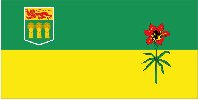 |
| Canada |
| Saskatchewan |
| Regina |
|
 |
Regina is the capital
city of Saskatchewan. The city is the second-largest in the
province (after Saskatoon) and a cultural and commercial centre
for southern Saskatchewan. Regina is the cathedral city of the
Roman Catholic and Romanian Orthodox Dioceses of Regina and the
Anglican Diocese of Qu'Appelle. It was named in 1882 after Queen
Victoria by her daughter Princess Louise, wife of the Marquess of
Lorne, then the Governor General of Canada.
Unlike other planned
cities in the Canadian West Regina was a tabula rasa, without
topographical features other than the small spring run-off
Wascana Creek. Early planners took advantage of such opportunity
by damming the creek to create a decorative lake to the south of
the central business district and constructing the elaborate 260
m long Albert Street Bridge across the lake. Regina's importance
was further secured when the new province of Saskatchewan
designated the city its capital in 1906. Wascana Centre remains
Regina's signal attraction and contains the Provincial
Legislative Building, both campuses of the University of Regina,
the provincial museum of natural history, the Regina
Conservatory, the Saskatchewan Science Centre, the Norman
MacKenzie Art Gallery and the Saskatchewan Centre of the Arts.
In 1912 Regina was a
focus of international attention when the Regina Cyclone
destroyed much of the town. In the 1930s, the Regina Riot brought
further attention and, in the midst of the 1930s drought and
Great Depression, which hit the Canadian Prairies particularly
hard with their economic focus on dryland grain farming.
< Back to the index



